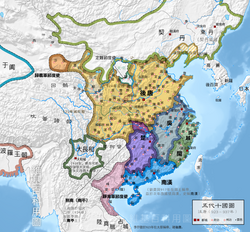Later Tang
| Tang / Later Tang | ||||||||||||||||||||
| 唐 / 後唐 | ||||||||||||||||||||
|
||||||||||||||||||||
|
Later Tang 後唐
|
||||||||||||||||||||
| Capital |
Daming (923) Luoyang (923–936) |
|||||||||||||||||||
| Languages | Chinese | |||||||||||||||||||
| Government | Monarchy | |||||||||||||||||||
| Emperor | ||||||||||||||||||||
| • | 923–926 | Li Cunxu (Zhuangzong) | ||||||||||||||||||
| • | 926–933 | Li Siyuan (Mingzong) | ||||||||||||||||||
| • | 933–934 | Li Conghou | ||||||||||||||||||
| • | 934–936 | Li Congke | ||||||||||||||||||
| Historical era | Five Dynasties and Ten Kingdoms Period | |||||||||||||||||||
| • | Established in Daming | May 923 | ||||||||||||||||||
| • | Overthrown by Khitan and Shi Jingtang | January 11, 937 | ||||||||||||||||||
|
||||||||||||||||||||
| Today part of |
|
|||||||||||||||||||
| The preceding entity of the Later Tang was the State of Jin, which was established by Li Keyong in 895 under the Tang Dynasty and existed as a state in 907–923. | ||||||||||||||||||||
Tang, known in history as Later Tang, was a short-lived imperial dynasty that lasted from 923 to 937 during the Five Dynasties and Ten Kingdoms period in the history of China.
The first three of Later Tang's four emperors were ethnically sinicized Shatuo. The name Tang was used to legitimize itself as the restorer of the Tang dynasty (618–907). Although Later Tang officially began in 923, the dynasty already existed in the years before, as a polity called Jin (907–923).
At its height, Later Tang controlled most of northern China.
From the fall of the Tang Dynasty in 907, a rivalry had developed between the successor Later Liang, formed by Zhu Wen, and the State of Jin, formed by Li Keyong, in present-day Shanxi. The rivalry survived the death of Li Keyong, whose son Li Cunxu continued to expand Jin territories at the expense of the Later Liang.
Li Keyong forged an alliance with the powerful Khitan, like the Shatuo a people of the northern steppe, a relationship that figured significantly in the expansion and ultimate triumph of the Shatuo. Li Cunxu was successful in overthrowing the Later Liang in 923 and proclaimed himself emperor of the Later Tang, which he referred to as the “Restored Tang”. As a part of “restoring the Tang”, the capital was moved back to the old Tang eastern seat of Luoyang.
The Later Tang was a short-lived regime, lasting only thirteen years. Li Cunxu himself lived only three years after the founding of the dynasty, having been killed during an officer’s rebellion in 926. Li Siyuan, the adopted son of Li Keyong, took over the dynasty, but relations with the Khitan had fallen sour. Internal struggles typified the remaining ten years of the dynasty, ending with its toppling in 936 when Shi Jingtang, son-in-law of Li Siyuan and a fellow Shatuo, rebelled, stormed the capital with the help of Khitan troops, and founded the Later Jin.
...
Wikipedia

